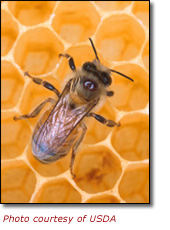Queen Succession in Honeybees Biology 342 Fall 07
by Laura Mulshine and Alice Runckel
 Queen Succession in Honeybees
Queen Succession in Honeybees
http://www.genome.gov/Images/feature_images/honeybee_image.jpg (Oct. 9, 2007)
Phylogeny
How do we know what we know?
Honeybee evolution has been well traced since humans began exploiting bees for agriculture. Currently in North America breeding focuses on crosses between African and European honey bees. Crossbreeds such as this have motivated studies of honeybee behavior because the two species differ in temperament. African honeybees are know to be much more “protective of their hive or brood” (USDA), and swarm more regularly, thus the nature of queen succession is likely to differ among these species.
Honeybees as eusocial insects.
The evolution of queen-queen interaction is highly influenced by the fact that honeybees function as a part of a greater colony, or that honeybees are eusocial insects. The phylogeny of eusociality is often debated and tends to occur in species that are under strong environmental pressure. Kin selection is often used to explain eusocial groups especially in haploid- diploid system like that of honeybees. However the eusocial systems evolved, they are currently in place (for the most part, see worker egg-laying in Adaptive Value), within western honeybees.
How does eusociallity affect queen-queen competition?
Eusocial society allows for queen-queen competition because it is beneficial for all members of the hive if there is only one reproducing female. Based on the concepts of kin selection it is most beneficial if there is only one queen in a honeybee colony, and therefore all workers are highly related to one another and to the queen’s offspring. This means that a female worker who cannot breed but can only care for the queen’s progeny is still passing on her genetic information because of her close relation to the queen and hence the queen's progeny. By this logic it is beneficial for worker bees to allow queen bees to suppress all other potential reproduction and allow her to kill all other queens. Having only one queen prevents genetic diffusion over generational time and ensures that workers are only rearing closely related larvae. This phenomenon is explained in Michener and Brothers (1974) article. Here siblings resulting form one mating of the queen are more closely related to one another than they are to the queen. This is because pairs of sisters share their mother’s and father’s genetic information where as a mother and daughter pair only share the mother’s genetic information. Thus by rearing their siblings, worker bees ensure that more of their genetic information is passed on than if they reproduced themselves and reared young that only contain half of their genetic information.
So, how has queen competition evolved?
We are not sure. What we do know is that within eusocial colonies, having more than one functional queen is an ancestral trait (Thompson 1918). Along with this ancestral trait of multiple queens, worker bees are also known to defend extraneous queen bees when environmental conditions are good and swarming is likely to occour (Tarpy 2000). Further in times of emergency when the old queen has unexpectedly died, workers can rear a novel queen from broods intended to be workers (Tofilski and Czekonska 2004). From these phenomena we presume that it is at some times beneficial to have multiple queens but this is not essential. Thus, the evolution of queen-queen competition has likely occurred independent of overall colony evolution and may simply have arisen and persisted based on individual queen fitness.
Where does this leave us?
In the case of phylogeny the queen succession behavior we are looking at is queen-queen killings among virgin queens. This behavior has apparently evolved from selection acting on the queen rather than on the whole colony, where being the only reproducing female improves her fitness. Finally, it is important to emphasize that while queen-queen competition may be independent of colony fitness the whole eusocial system is not and the major force driving the evolution of eusociallity of honeybees is unknown and heavily debated.
Random tid-bit
Interestingly enough, bees are not considered domesticated animals because as Hambelton (1934) points out the workers that bee keepers have interactions with are not responsible for breeding. Here the mateing queens and drones do not interact heavily with humans and are therefore under different artificial selection.
Image from http://www.dkimages.com/
The large central bee is the queen surrounded by workers, she is attracting these attendants through hormonal cues.
